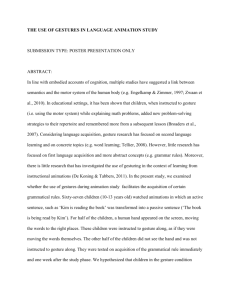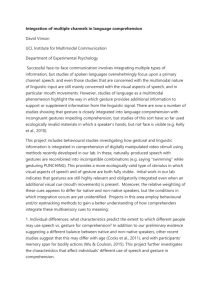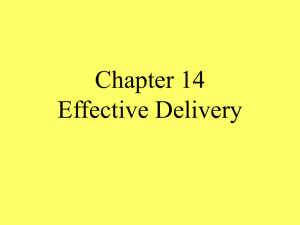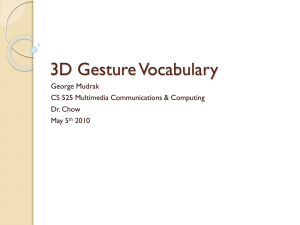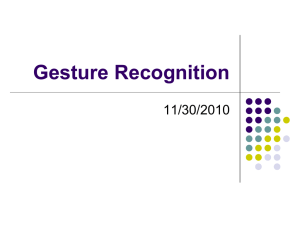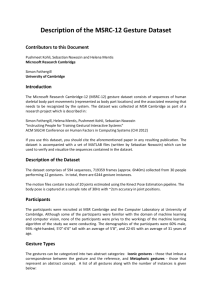Non-verbal & Visual Communications
advertisement
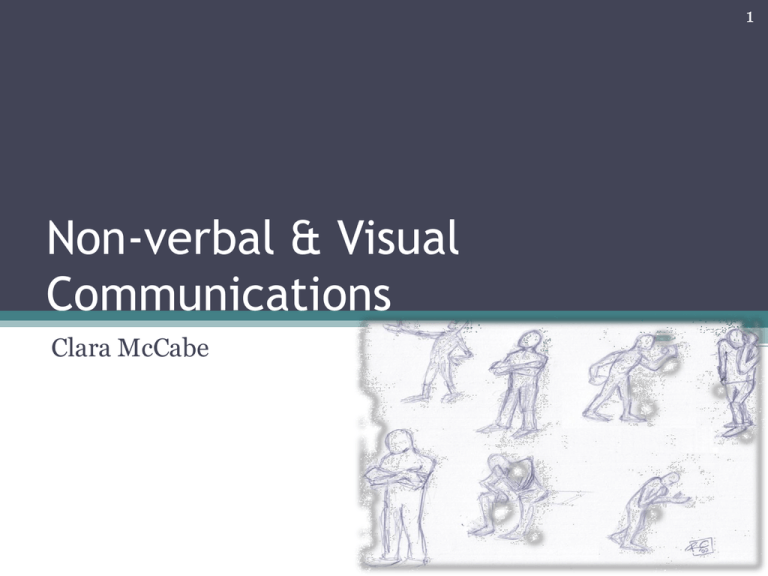
1 Non-verbal & Visual Communications Clara McCabe 2 Non-verbal Communication • Most influential pre 20th century work on study of body language was Charles Darwin’s The Expression of the Emotions in Man and Animals – published in 1872. • This spawned the modern studies of facial expressions and body language and many of Darwin’s ideas and observations have been validated by modern researchers. • Albert Mehrabian found that the total impact of a message is about: 7 % verbal ( words only) 38% vocal ( tone of voice) 55% non-verbal • Basically the verbal component of a face to face conversation is less that 35%, and over 65% of communication is non-verbal. 3 What we will look at. • • • • Territory and zones Gestures Hand to face expressions Eye signals Territories and Zones Personal Zone 18” – 4’ Public Zone 12’ and up Social Zone 4’ – 12’ Intimate Zone Touching – 18” 4 5 • Territory is an area of place that a persona claims as his own, as if it were an extension of his body. • Each person has his own personal territory and when this space is ‘invaded’ we react. 6 1. The intimate zone ( 15cm-45cm) This is by far the most important zone as it is this zone that a persona guards as if it were his on property. Only those who are emotionally close to that person are permitted to enter. This includes lovers, parents, children, close friends, etc. 2. Personal Zone ( 46cm-1.2 m) This is the average distance we stand from others at parties, social functions and friendly gatherings. 3. Social Zone ( 1.2m – 3.6m) On average, we stand this distance from strangers. For example, a new employee at work, a repair man in our home, etc. 4. Public Zone ( over 3.6m/12 feet) This is usually the most comfortable distance at which we stand whenever we address a large group of people. 7 Our Intimate Zone is Invaded. • Crowding at concerts, cinema, in elevators, buses, etc., is an unavoidable intrusion into one’s intimate zone. Reactions to these intrusions are interesting to observe. • There are unwritten rules in Western culture that people follow when faces with a crowded situation. 1. 2. 3. 4. 5. 6. You are not permitted to speak to anyone You must avoid eye contact You are to remain ‘poker face’ – display no emotion If you have a book/paper, appear to be deeply engrossed Limit you body movement In elevators, you are compelled to watch the floor numbers If you doubt this, notice how you behave the next time you are alone in a crowded space. 8 Gestures. 1. Palm gestures. The open palm has been associated with truth, honesty, allegiance and submissions. When people wish to be totally open or honest they hold one or both palms out to the other person. Like most body language, this is completely subconscious. If we are trying to conceal information we often hide our palms either in our pockets or behind out back. 9 • There are 3 main palm command gestures: 1. 2. 3. The palm up position The palm down position The palm-closed-finger-pointed position 10 • 2. Shaking Hands. Shaking hands is a relic from the caveman era. Whenever cavemen met, they would hold their arms in the arm with their palms exposed to show no weapons were being concealed. This palms in the air gesture was modified over centuries The modern for of this ancient greeting is the interlocking and shaking of the palms. 11 • When you meet somebody for the first time and you greet each other with a hand shake – 1 of 3 basic attitudes are transmitted through the handshake. 1. Dominance 2. Submission 3. Equality 12 • Disarm a dominant handshake. 13 Hand, Arm & Body Gestures. Watch this clip by a former FBI agent, Joe Navarro, as he describes how torsos, hands, feet and legs communicate without words What We Say Without Words 14 3. Facial Expression See no evil, speak no evil, hear no evil. 15 • The Mouth Guard. The brain is subconsciously trying to suppress the Deceitful words that are being said. If a person who is speaking uses this gesture, it indicates That they are lying. If, however, the person covers their mouth while you are speaking, it indicated that they feel you are lying 16 • Nose Touching. In essence, the nose touch gesture is a sophisticated, disguised version of the mouth guard gesture. • One explanation of the origin of the nose touch gesture is that, as the negative thought enters the mind, the subconscious instructs the hand to cover the mouth, but, at the last moment, in an attempt to appear less obvious, the hand pulls away from the face and a quick nose touch gesture is the result. • Another explanation is that lying causes the delicate nerve endings in the nose to tingle, and the rubbing action takes place to satisfy this feeling. 17 • The Eye Rub. See no evil’ says the wise monkey, and this gesture is the brain’s attempt to block out the deceit, doubt or lie that it sees or to avoid having to look at the face of the person to whom he is telling the lie. • The Ear Rub. This is, in effect, an attempt by the listener to ‘hear no evil’ in trying to block the words by putting the hand around or over the ear. 18 • The Neck Scratch. This gesture is a signal of doubt or uncertainty and is characteristic of the person who says, ‘I’m not sure I agree.’ It is very noticeable when the verbal language contradicts it, for example, when the person says something like, ‘I can understand how you feel.’ The Collar Pull Research into the gestures of those who tell lies revealed that the telling of a lie caused a tingling sensation in the delicate facial and neck tissues and a rub or scratch was required to satisfy it. This seems to be a reasonable explanation of why some people use the collar pull gesture when they tell a lie and suspect that they have been caught out. 19 • Fingers in the Mouth. Fingers are placed in the mouth when a person is under pressure. It is an unconscious attempt by the person to revert to the security of the child sucking on his mother’s breast. Whereas most hand-to-mouth gestures involve lying or deception, the fingers-in-mouth gesture is an outward manifestation of an inner need for reassurance. at this clip on how to spot a liar. How to Spot a Liar 20 Analyse non-verbal communication • Watch the following film extract from The Pursuit of Happiness. • Please note the actors’ use of body language. The Pursuit of Happiness





